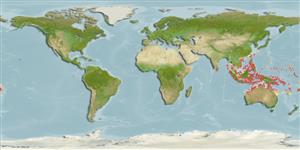Classification / Names
Common names from other countries
Main reference
Size / Weight / Age
Max length : 12.0 cm TL male/unsexed; (Ref. 9710); common length : 8.5 cm SL male/unsexed; (Ref. 37816)
Environment
Marine; reef-associated; depth range 2 - 20 m (Ref. 37816)
Climate / Range
Tropical, preferred ?; 30°N - 24°S
Distribution
Indo-West Pacific: Malaysia east to Palau in Micronesia and the Solomon Islands, north to the Ryukyu Islands and south to the Great Barrier Reef.
Countries | FAO areas | Ecosystems | Occurrences | Introductions
Short description
Dorsal
spines
(total): 8;
Dorsal
soft rays
(total): 9;
Anal
spines: 2;
Anal
soft rays: 9. Color is white or pinkish with about six red-brown stripes on side; 3-4 dark spots at the base of the caudal fin. Eyes iridescent blue. Small juveniles have yellow caudal peduncle with black spot in centre, mimicking the large-toothed Cheilodipterus species. That enables them to swim about more freely (Ref. 48635).
IUCN Red List Status (Ref. 115185)
Threat to humans
Harmless
Human uses
Aquarium: potential
More information
ReferencesAquacultureAquaculture profileStrainsGeneticsAllele frequenciesHeritabilityDiseasesProcessingMass conversion
Tools
Special reports
Download XML
Internet sources
Estimates of some properties based on models
Phylogenetic diversity index
PD50 = 0.5000 many relatives (e.g. carps) 0.5 - 2.0 few relatives (e.g. lungfishes)
Trophic Level
3.5 ±0.50 se; Based on food items.
Resilience
High, minimum population doubling time less than 15 months (Preliminary K or Fecundity.)
Vulnerability
Low vulnerability (13 of 100)
Price category
